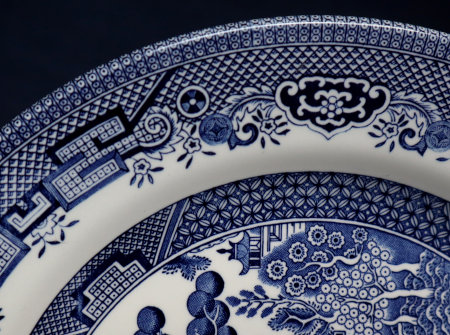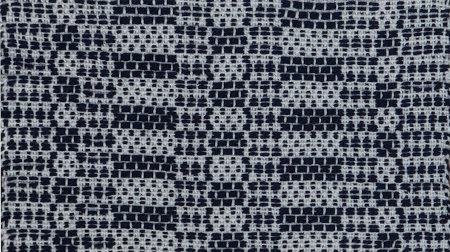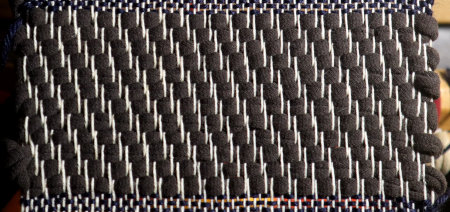Poly (many), chrome (colors). In weaving, polychrome describes a
category. The effect is produced by using a variety of weft colors, treadled
in one of several ways to create blocks of color.
I particularly like Susan Wilson's definition of polychrome, because it's
based on her research of the weaving literature to find the common factors in
all the definitions. I think this is important, because I'm seeing that many
books describe only one of the various polychrome treadling patterns.
Polychrome Characteristics
- multiple weft colors (2, 3, or 4)
- typically a single warp color
- the treadling pattern creates blocks of color side by side
- includes a variety of treadling methods
-
commonly used with crackle, but also overshot and summer & winter
Because polychrome covers a number of treadling methods, I chose a few to
start and added examples from other blog posts. I may try more later,
depending on how much sampler warp I have.
Resources
Usually, I put my resources at the end of the post, but since I'm picking and
choosing from them for
my sampler, I'll list them here and refer to the page numbers with each sample.
- Snyder, Mary E., The Crackle Weave (1961 edition)
- Brusic, Lucy M., A Crackle Weave Companion
- Wilson, Susan, Weave Classic Crackle & More
Sample #7: Polychrome Blocks (Snyder page 101, Brusic pages
52-53)

|
|
#7 Polychrome Blocks
|
- 4 weft colors
- woven in overshot manner
- rotates 2 colors per block
- pattern weft is one color
- tabby is a different color
- rotate through the four colors as follows:
- Block 1 (lift shafts 1-2)
- pattern: color #1
- tabby: color #2
- Block 2 (lift shafts 2-3)
- pattern: color #2
- tabby: color #3
- Block 3 (lift shafts 3-4)
- pattern: color #3
- tabby: color #4
- Block 4 (lift shafts 4-1)
- pattern: color #4
- tabby: color #1

|
|
Sample #7 polychrome blocks detail
|
Weaving Notes
-
In my first picture, I can't see my blocks as distinct entities and am
pondering this.
-
Firstly, I'm thinking heavier pattern wefts would bring out the blocks
more.
-
Snyder's study recommends using 10/2 for both warp and weft, set at 24
e.p.i. I'm using 10/2s but my sett is 20 e.p.i. (as per Wilson's sampler instructions.) Can't help but wonder if I wouldn't like the tighter sett better.
-
Also, I'm thinking the light color warp washes out the color effect of
the blocks. I'll have to experiment with a darker warp in the future.
-
Getting the sampler off the loom and wet finished with make a difference
also.
-
In general, the draft seemed complicated at first, but the sheds and
color rotation are logical and easy to follow.
Sample #8: Traditional Polychrome (Wilson, pages 54, 57, 58)

|
|
#8 Traditional Polychrome Crackle
|
- 3 shuttles
- 2 pattern wefts in different colors
- 1 tabby weft, can be same as warp or a different color
- colors and tabby are rotated in the same sequence throughout
-
treadling is a 6 pick sequence (translated here as a lift plan because I'm
using a table loom)
- Block A
- 3-4 (weft color 1)
- 1-4 (weft color 2)
- tabby a
- 3-4 (weft color 1)
- 1-4 (weft color 2)
- tabby b
- Block B
- 1-4 (weft color 1)
- 1-2 (weft color 2)
- tabby a
- 1-4 (weft color 1)
- 1-2 (weft color 2)
- tabby b
- Block C
- 1-2 (weft color 1)
- 2-3 (weft color 2)
- tabby a
- 1-2 (weft color 1)
- 2-3 (weft color 2)
- tabby b
- Block D
- 2-3 (weft color 1)
- 3-4 (weft color 2)
- tabby a
- 2-3 (weft color 1)
- 3-4 (weft color 2)
- tabby b
Weaving Notes
-
In light of my observations for sample #7, I decided to use a heavier
pattern weft.
- warp and tabby are 10/2 in natural
- pattern wefts are red and dark gray in 6/2
- I think that was a good choice.
More examples of polychrome from previous posts projects
- In weaving, opposites can refer to either:
-
Alternating opposite sheds. For example, a shed from shafts 1-2 is
alternated with 3-4. Contrasting colors are used for the wefts. Tabby is
optional, but produces a more stable fabric.
-
Pattern blocks. For example, one pattern block is treadled with shafts 2-3 for so many shots, and then treadled 1-2 for so many
shots. The second block is treadled with the opposite shafts 4-1 and
3-4. With this treadling, tabby must be used to avoid long warp floats.
- produces a weft-faced fabric
-
See Weaving On Opposites for more information.











































